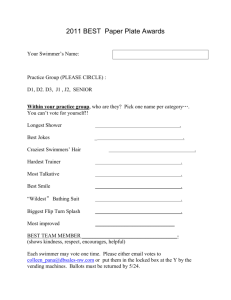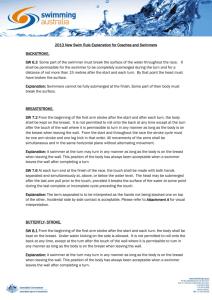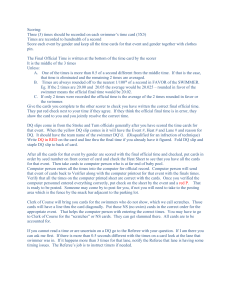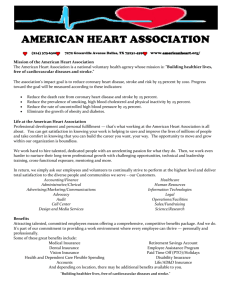Stroke & Turn Clinic
advertisement
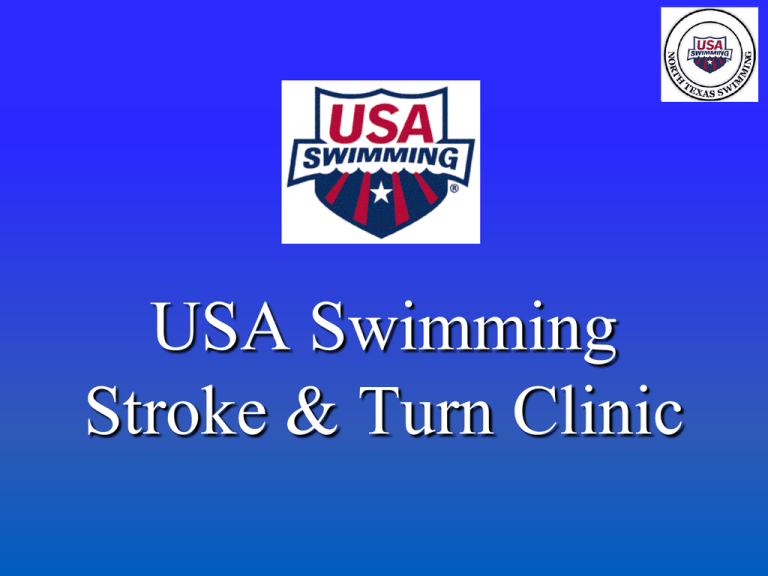
USA Swimming Stroke & Turn Clinic Clinic Logistics • Timeline, facilities • Bathrooms • Breaks • Introductions • Clinician(s) • You! – Club – Children in swimming? – Years of experience at a swim meet – Why you’re here Agenda 1 2 3 4 5 6 7 • Officiating philosophy • Rules • Judging process • Assignment and jurisdiction of officials • Officials’ uniform • Certification requirements • Resources Motivation for Volunteering • Wanted to do something useful • Thought I would enjoy the work • Family member or friend would benefit • Previously benefited from activity • Wanted to learn; to get experience Reasons for Volunteering • • • • • • • • • • To use skills in a new setting To explore new interests To gain work experience To learn new skills To find new friends To develop a sense of accomplishment and self worth To challenge oneself To work for a cause To gain recognition for ones abilities To meet requirements of a course or program Officiating Philosophy Fair and equitable conditions of competition are maintained and uniformity in the sport is promoted so that no swimmer has an unfair advantage over another. What does that mean? • Success of every meet depends on the official’s integrity, knowledge, concern and regard for the competitive interest of the swimmer • • • • One set of rules applies to all swimmers Swimmers get the benefit of the doubt We do not judge style Demonstrate impartiality and professionalism on deck “Goals” by Officiating • Ensure a safe environment on deck and in • • • the water Fairness to all competitors, giving the benefit of the doubt, in every instance, to the swimmer Identify “improvement areas” for coaches and swimmers Have fun!!! Basic Concept 1: Take officiating seriously and work hard at it 1. Study USA Swimming’s official rulebook 2. Uniformly interpret and apply rules regardless 3. 4. 5. 6. of the levels of athletes Call violations as seen; don’t guess or anticipate (Use “DQ-slip” as memory jogger) Be fair and consistent; always give the benefit of the doubt to the swimmer Disregard club affiliation Exercise good judgment Basic Concept 2: Work regularly at the job. 1. Officials need practice, just as competitors do 2. Working regularly builds confidence 3. Attend training sessions regularly to keep up with rule changes and new interpretations 4. There is no substitute for experience Basic Concept 3: Be professional in manner 1. 2. 3. 4. 5. Fairness to all competitors must dictate actions Dress properly Make decisions quickly and decisively Avoid coaching swimmers Admit a mistake if wrong, competitor’s welfare is more important than your own ego. Basic Concept 4: Uniform (North Texas) • White top (polo shirt) • Navy pants, slacks, skirt or shorts • White footwear with rubber soles (Prelim – Finals Meet – Final session) • Navy top (polo shirt) • Khaki slacks, skirt or shorts • White footwear with rubber soles USA Swimming • HQ – Denver, CO • Divided into – Zones (4) – Regions (14) – LSC’s (59) • Texas – 5 LSC’s NT – North Texas The rules of swimming • USA Swimming rules: – Found online at USA Swimming – In USA Swimming rulebook which will be sent to you in late January • Shall and must • May Rules • Review rules before every swim meet • A stroke briefing is conducted at the officials meeting held before each session • Refer to your rulebook or ask other officials for clarification when you are unsure • The answers to all questions in the online test can be found in the USA Swimming rulebook Be sure to use 2014 rulebook for online test For Masters Swimming questions, refer to complete online rulebook The officials team • Referee • Starter • Administrative Official • Chief Judge • Stroke & Turn Judge • Meet Director • Timers We swim four strokes Components of a stroke – START – from the start of race until head breaks the surface – SWIM – from head breaking surface until beginning of last stroke into the turn/finish – TURN – from the beginning of the last full stroke into the wall until head breaks the surface – FINISH – from beginning of the last full stroke into the wall to the touch at the end of the prescribed distance OR at the time the judge shifts the vision to watch the wall at the touch Freestyle • What to look for: – Any stroke(s) – Any kick(s) – Swimmer must touch the wall at each turn and at the finish; any part of the body may be used – At start and turns, head must break surface of water by the 15 meter mark • Head = chin Backstroke • What to look for: – Start in water with back to the course • Feet and toes may not be in or bend over the edge of the gutter – Swim on back – Any stroke(s) – Any kick(s) – Some part of swimmer must touch the wall at completion of each length, and at the finish, on back Backstroke • If submerged at the start and turns, head must break the water surface by the 15 meter mark – Head = chin • At each turn, the swimmer MAY: – Turn to breast and may utilize a continuous single or continuous simultaneous double arm pull to initiate the turn – The backstroke “flip turn” – Once swimmer touches wall, the turn is complete – Swimmer leaves wall on back Breaststroke • What to look for: – Forward start – Must swim on the breast – Cycle stroke: one pull and one kick, in that order; • Head breaks surface every cycle – Pull: Simultaneous arm movement in same horizontal plane • Hands recover from the breast on, • under or over water Elbows under water except last stroke before turn or finish Breaststroke – Kick: Simultaneous vertical and horizontal movements of the legs; feet turned out during propulsive phase – At turns and finish: • body must be on the breast; • Touch must be made with both hands -- separated and simultaneously -- at, above or beneath the water’s surface • Shoulders at or past vertical toward breast when feet leave wall Breaststroke pullouts • After the start and each turn: – During first arm pull, hands MAY be brought completely beyond hip line – Swimmer MAY at any time prior to the first breaststroke kick, take a single butterfly kick – Head must break surface at widest part of second pull Butterfly • What to look for: – Must swim on breast – Pull: Arms must be brought forward simultaneously over water and recovered simultaneously under the water – Kick: All up and down movement of the feet and legs must be simultaneous – At turns and finish, touch must be made with both hands -- separated and simultaneously -- at, above, or below the water’s surface Butterfly start and turns – If submerged at start and following turns, head must break surface by 15 meter mark – One arm pull under water is allowed which must bring swimmer to surface – After each turn, swimmer must return to breast – No cycle: swimmer may take as many kicks or pulls as he/she likes Individual medley • Forward start • Butterfly, backstroke, breaststroke, freestyle – Freestyle is any stroke not in the style of the other three • Rules for each stroke apply – Intermediate turns conform to turn rules for that stroke – Transition turns conform to finish rules for that stroke – Freestyle start and turn must be toward the breast off the wall Medley relay • Backstroke, breaststroke, butterfly, freestyle – Freestyle is any stroke not in the style of the other three • Rules for each stroke apply – Intermediate turns conform to turn rules for that stroke – Transition turns conform to finish rules for that stroke • No swimmer shall swim more than one leg • Each swimmer must leave the pool immediately upon finishing his/her leg, except the last swimmer USA Stroke & Turn Training Video Legal? or not? Infractions: all strokes • • • • • • • • • Did not finish Walking on or pushing off the bottom Pulling on lane lines Not touching the wall at each end Interfering with another swimmer Not starting and finishing in the same lane Unsportsmanlike conduct Delay of meet (Referee’s jurisdiction) False start (Starter’s and Referee’s jurisdiction) Judging swimmers with physical disabilities • Rule 105 – Newly rewritten • If there are swimmers with disabilities participating, Referee will notify judges in advance • Judge any part of that body that is used • Do not judge a part of the body that cannot be used • Base your judgment on the rule, not the swimmer’s technique Relay take-off judging • Referee or Chief Judge assigns positions • Lane judge stands beside the blocks and looks to side of pool (inside out); side judge stands at edge of pool and looks inward (outside in) • “Toes to Nose” When the toes of the outgoing swimmer leave the blocks, look down to see if the incoming swimmer has touched Relay take-off slip • If you observe an early take-off, mark x on the swimmer # for that lane. Do not raise your hand as dual confirmation is required. • Referee or designee will collect all slips after the event is complete in order to check for dual confirmation of early takeoffs. When you observe an infraction • Upon observing an infraction within your jurisdiction, raise your hand overhead – Keep your hand up long enough that it is clearly seen by Referee, Chief Judge, and Coach • If you raise your hand, you don’t have to make a call. If you don’t raise your hand, you cannot make a call • The benefit of the doubt goes to the swimmer • After signaling a DQ, continue to observe all the swimmers in your jurisdiction When observing a violation • Did it happen inside my jurisdiction? • RAISE YOUR HAND with a straight arm • • • above your head REVIEW – THINK – What did I really observe?? Be ready to tell the Chief Judge about your observation and explain why it was a violation Remember, you can always recall your decision after raising your arm. When you observe an infraction • Make notes on your heat sheet of your jurisdiction and what you observed – You will develop a shorthand that works for you • When you have no swimmers in your • jurisdiction, or between heats, complete DQ slip The disqualification slip (DQ) is the primary means of articulating a disqualification to coach and swimmer How to complete a disqualification (DQ) slip Disqualification slip • Always record Event #, Heat #, Lane # • Name of swimmer or team (optional but helpful) • Violation – most, but not all, are printed on the slip • Your PRINTED name and trainer’s initials • Referee’s signature – the Referee must approve the DQ – Runner – Walk to Deck Referee (find the whistle) – Send with stroke judge or Chief Judge Disqualification slip (cont’d) • Definitions: – START – from the start of race until head breaks the surface – SWIM – from head breaking surface until beginning of last stroke into the turn/finish – TURN – from the beginning of the last full stroke into the wall until head breaks the surface – FINISH – from beginning of the last full stroke into the wall to the touch at the end of the prescribed distance OR at the time the judge shifts the vision to watch the wall at the touch Disqualification slip (cont’d) • If clarification is needed, be prepared to answer these three questions to Chief Judge or Referee: – What was your jurisdiction? – What did you see? • Paint a picture • Keep your hands still – Which rule was violated? • Use rulebook terminology Disqualification process • S&T judge observes infraction within his/her jurisdiction • • • • • and raises hand S&T judge, or Chief Judge, completes a disqualification slip S&T Judge, Chief Judge, or designated person ensures DQ slip is transferred quickly to Referee for approval Referee approves DQ slip and delivers slip to Admin Judge who processes the information – Note: Referee has authority to overturn the disqualification Copy of the slip delivered to swimmer’s coach Final results reflect the swimmer’s disqualification Disputes over calls by coaches or parents • Parents with questions should contact their Coach, who in turn may contact the Meet Referee • Coaches with questions should contact a Referee – Direct coach nicely; do not answer questions • Do not talk about calls with other officials on the deck or with club parents or friends in the stands or anywhere • Only ask about a call in the officials room during a meeting NTS Official Uniform • Plain white collared shirt • • • • • (tucked in) Tailored navy blue pants, shorts or skirt (no denim) White socks White non-skid shoes USA credentials Nametag Preparing for the meet • Prior to meet, communicate with Referee that you wish to continue your training – Find Meet Packet on NTS website or your team’s site • Read up on rules prior to the meet, and bring • • your USA Swimming rulebook with you Wear the uniform and display your credentials Sign in to officiate; find out time of officials meeting Preparing for the meet (cont’d) • Attend the officials briefing prior to the meet to receive instructions and assignments – Meet trainer – Find out how heat sheets will be distributed – Bring a writing implement (and clipboard) • Bring your on deck training card for the official you worked with to complete with you and sign Meet Organization Meet Referee Admin Referee* Clerk of Course Entries Registration OVC’s Marshals Head Starter* Starters Meet Director Deck Referee* Chief Judge* Stroke & Turn Judges Head Timer Timing Equipment Operator & Timing Judge Timers & Recorders Computer Operator & Desk Personnel Positions around the pool 8 7 6 5 4 3 2 1 Jurisdictions 8 7 6 5 4 3 2 1 Types of judges • Stroke Judge – sometimes called Walker, walks the sides of the pool; may be two walkers on each side called lead-lag – Also responsible for 15 meter mark for freestyle, backstroke, butterfly, and medley events – Responsible for half the lanes – Referee determines jurisdiction for each stroke • Turn Judges – stand at both ends of the pool – Responsible for turns and finishes – May be responsible for one or more lanes, most likely 2-3 lanes – Referee determines jurisdiction for each stroke • Stroke and Turn Judge – judge both stroke and turns, jurisdiction is end wall to mid-pool – Often used in short course, when there are insufficient officials, or pool design precludes walkers Position of Turn Judge • At least one foot at edge of pool • • • • (balance!) Hands and papers (heat sheet, DQ slips, clipboard, etc.) behind back or by sides when swimmers are in your jurisdiction Look calm and professional Step back when no swimmers are in your jurisdiction If not directed where to stand by Referee, stand where you can see the swimmers in your jurisdiction Fair and Equitable Judging • Judging should be consistent among different • • officials at a meet Judging should be consistent at different meets All of the rules are enforced – We don’t individually choose to enforce some rules and ignore others Fair and Equitable Judging • The rules are enforced across all age groups and levels of ability • Officials demonstrate impartiality in their enforcement of the rules • Take officiating seriously and work at it. Competitors have a right to expect officials to know the rules and interpret them correctly, fairly, consistently, and courteously Mental Traps • • • • • Advantage vs. disadvantage The “twice theory” “We don’t disqualify 8&Under swimmers” Don’t infer – call what you see, not what you don’t see Don’t ask me to judge my child Conduct • No outward manifestations during a race regarding illegality of competitor except raised hand (NO pointing). • Do NOT cheer, coach or swap disqualifications; control your emotions • Minimize/avoid fraternization with swimmers, coaches or spectators; disregard club affiliation and personal relationships. Need to remain unbiased. Conduct • Do not concentrate on frequent violators to the exclusion of others • Give undivided attention – start to finish • If uncertain of role, consult with the Referee (if you are on deck, make a call and report) Stroke and Turn Judge Requirements to Complete Certification • Join USA Swimming/North Texas Swimming and display registration card while on deck ($52) – Must do background check Level 2 through USA Swimming ($39) – Must complete USA Swimming online Athlete Protection Training (FREE, but must be registered) http://www.usaswimming.org/protect • Attend training clinic and pass online test • Satisfactorily complete on deck training sessions For your training sessions… • Try to contact the Meet Referee in advance to see if good training can be accomplished. • Always carry your USA-S Membership Card and Officials Certification Card – You will be asked to show these to the meet referee • Seek excellent, experienced deck mentors. • Get Feedback! Always try to improve. • Use the updated training cards Carry your cards All dates current! Yours will show Stroke & Turn, Level T After Training • Complete your S&T online test • After completing your test, and when you are finished with your training sessions, scan (or photograph) and email complete set of cards to the Officials Chair – Be sure you have taken your test • Congratulations! • Print and carry your new Certification Card for your next session. Continuing your Stroke & Turn Judge certification • Renew membership with NTS and USA Swimming • • • each year Keep Level II Background Check and Athlete Protection Training current Take online recertification test every two years or attend NTS Annual Officials Recertification Clinic Work a minimum of 10 sanctioned meet sessions every year to recertify – Your training sessions will count – Swim season year (Sept. 1 – Aug. 31) – Tracked in OTS; you have capacity to track your own Resources • www.ntswim.org – Officials section • www.usaswimming.org – Volunteers • Officials –Rules & Regulations –Officials Online Tests –Training Resources – Officials Swimming Manual If all else fails – ASK! • Use all resources available –Other officials –Referees –Area Officials Reps –Officials Chair –Officials Committee Stroke & Turn Certification • Attend S&T Clinic • Register as USA Swimming Non-Athlete • S&T Tests (USA Swimming On-line/open book ) – S&T – Timer • Apprentice on deck (BB, B/C level, or unclassified) – As observer, Min 5 sessions – As “primary”, Until recommended to apply • Work 10 sessions annually at 3 or more meets Wrap up – Questions ? Thanks for your participation! & GOOD LUCK!

